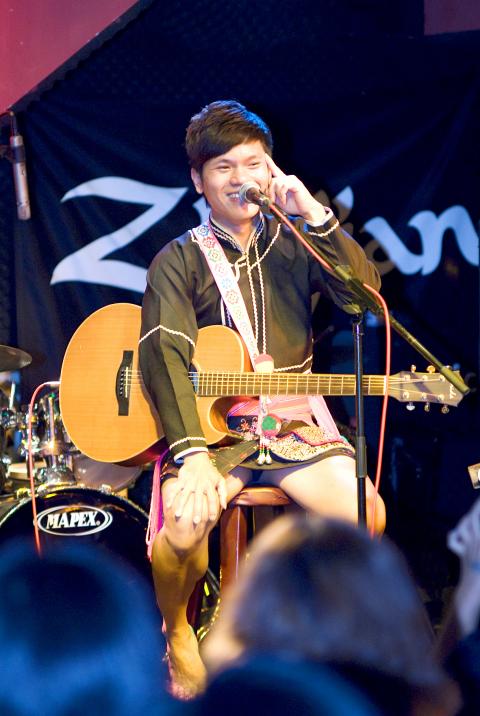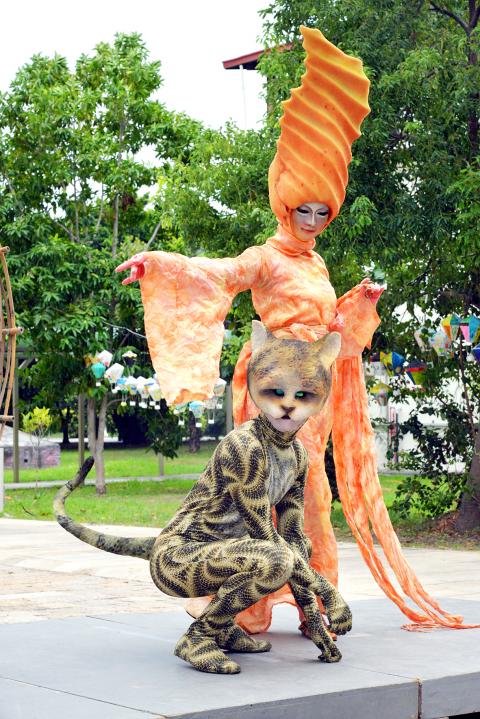If spending the holiday season immersed in Taiwan’s indigenous music and arts in picturesque Taitung sounds like fun to you, look no further than the series of shows and street performances slated to take place over the following two weekends at Fantasy Tiehua (鐵花新聚落), a new art and cultural venue, renovated from Taitung City’s old train station.
Tomorrow and Sunday, some of the country’s leading indigenous musicians will perform on the former train platform amid green lawns. Participating artists and groups include Puyuma songstress Samingad (紀曉君), Amis singer-songwriter Suming (舒米恩), Amis musician Ilid Kaolo (以莉·高露) and Kuskus (高士古謠隊), a youth ensemble aiming to revive the ancient sounds of Paiwan.
Music performances on both days run from 5pm to 6:30pm.

Photo courtesy of Fantasy Tiehua
Next weekend, the adjacent Tiehua Road (鐵花路) will be turned into an outdoor performance space occupied by musicians and street artists. Several large street performances will also take place by groups such as Formosa Circus Art (福爾摩沙馬戲團) and Headspring Theater (匯川聚場).
The tourist center of Fantasy Tiehua is located at 369 Tiehua Rd, Taitung City (台東市鐵花路369號). All activities are free. For more information, visit the event’s bilingual Web site at tiehua.tw and Facebook page at www.facebook.com/fantiehua.

Photo courtesy of Fantasy Tiehua

May 26 to June 1 When the Qing Dynasty first took control over many parts of Taiwan in 1684, it roughly continued the Kingdom of Tungning’s administrative borders (see below), setting up one prefecture and three counties. The actual area of control covered today’s Chiayi, Tainan and Kaohsiung. The administrative center was in Taiwan Prefecture, in today’s Tainan. But as Han settlement expanded and due to rebellions and other international incidents, the administrative units became more complex. By the time Taiwan became a province of the Qing in 1887, there were three prefectures, eleven counties, three subprefectures and one directly-administered prefecture, with

President William Lai (賴清德) yesterday delivered an address marking the first anniversary of his presidency. In the speech, Lai affirmed Taiwan’s global role in technology, trade and security. He announced economic and national security initiatives, and emphasized democratic values and cross-party cooperation. The following is the full text of his speech: Yesterday, outside of Beida Elementary School in New Taipei City’s Sanxia District (三峽), there was a major traffic accident that, sadly, claimed several lives and resulted in multiple injuries. The Executive Yuan immediately formed a task force, and last night I personally visited the victims in hospital. Central government agencies and the

Among Thailand’s Chinese Nationalist Party (KMT) villages, a certain rivalry exists between Arunothai, the largest of these villages, and Mae Salong, which is currently the most prosperous. Historically, the rivalry stems from a split in KMT military factions in the early 1960s, which divided command and opium territories after Chiang Kai-shek (蔣介石) cut off open support in 1961 due to international pressure (see part two, “The KMT opium lords of the Golden Triangle,” on May 20). But today this rivalry manifests as a different kind of split, with Arunothai leading a pro-China faction and Mae Salong staunchly aligned to Taiwan.

As with most of northern Thailand’s Chinese Nationalist Party (KMT) settlements, the village of Arunothai was only given a Thai name once the Thai government began in the 1970s to assert control over the border region and initiate a decades-long process of political integration. The village’s original name, bestowed by its Yunnanese founders when they first settled the valley in the late 1960s, was a Chinese name, Dagudi (大谷地), which literally translates as “a place for threshing rice.” At that time, these village founders did not know how permanent their settlement would be. Most of Arunothai’s first generation were soldiers